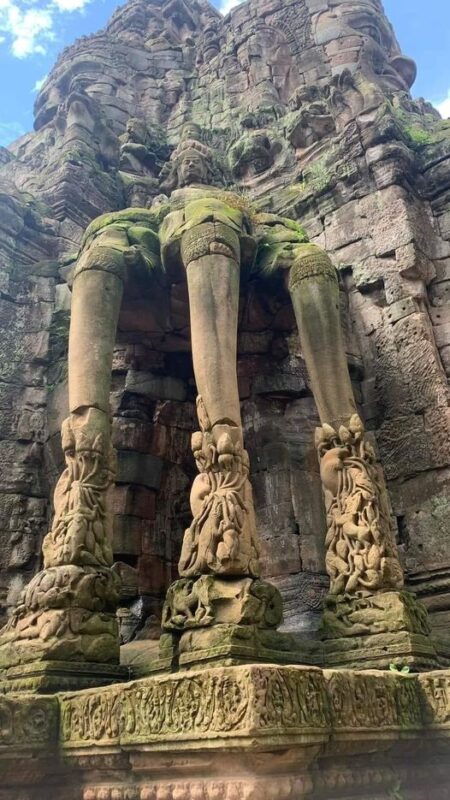The Gate of Angkor Thom in Cambodia is not merely an entrance; it serves as a breathtaking passage to a bygone era. This monumental structure is a testament to the Khmer Empire’s architectural genius and cultural richness. Let’s dive into the stories, details, and mysteries that this ancient gateway holds.Let’s explore with archeology.dulichvn.net now!

The Architectural Marvel of Angkor Thom Gate
The Gate of Angkor Thom is a masterpiece of Khmer architecture, blending functionality with intricate artistry.
1. The Design and Structure of the Gate
The gate stands tall and imposing, with a central tower rising to a height of 23 meters. Its design includes four faces carved into the stone, believed to represent the Bodhisattva Avalokiteshvara, symbolizing compassion and watchfulness.
2. The Intricate Carvings
Each inch of the gate is adorned with detailed carvings depicting scenes from Hindu mythology, battles, and the daily life of the Khmer people. These carvings are a window into the past, showcasing the Khmer Empire’s cultural depth and devotion.
3. The Gate’s Strategic Purpose
Apart from its artistic significance, the gate also served as a protective barrier. It was part of a larger wall surrounding Angkor Thom, safeguarding the capital city from potential invaders.

Stories Hidden in Stone
The carvings on the gate are not just decorative; they narrate tales that have withstood the test of time.
1. Mythological Tales
Many carvings depict scenes from Hindu epics like the Mahabharata and Ramayana. These stories reveal the spiritual beliefs that deeply influenced Khmer culture.
2. Historical Events
The bas-reliefs also chronicle significant historical events, such as battles fought during the reign of King Jayavarman VII, the ruler who established Angkor Thom.
3. Everyday Life of the Khmer People
Interestingly, some carvings illustrate the daily activities of the Khmer people, providing a glimpse into their lives, traditions, and occupations.

Who Passed Through the Gate?
One of the most intriguing aspects of Angkor Thom Gate is imagining the people who walked through it centuries ago.
1. Royalty and Nobility
The gate was a primary access point for the royal family and nobility entering the grand city of Angkor Thom.
2. Pilgrims and Traders
Pilgrims and traders from across Asia traversed this gateway, contributing to Angkor’s vibrant cultural and economic exchanges.
3. Soldiers and Workers
The gate also saw soldiers marching to defend the empire and laborers bringing resources to construct and maintain the city’s majestic temples.
See more: The Twelve-Angled Stone in Cusco: A Testament to Ancient Ingenuity
Conclusion
The Gate of Angkor Thom is not just a physical structure but a living piece of history. It stands as a testament to the artistic brilliance and cultural richness of the Khmer Empire. Whether you’re an architecture enthusiast or a history lover, this gateway offers a unique opportunity to step back in time and immerse yourself in the stories etched into its stone.


CÁC TIN KHÁC
Mark Twain & Olivia Langdon: A 36-Year Love Story Filled with Laughter and Devotion
The Tollund Man: A 2,400-Year-Old Mystery Preserved in a Danish Bog
Skara Brae: Scotland’s Hidden Neolithic Village
Porta Nigra: The Hidden Depths of Trier’s Iconic Roman Gate